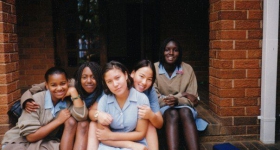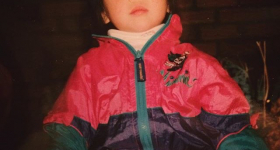Jamie Oliver thinks every American should know an Asian recipe or two. Last fall, he arrived in Huntington, WV, where half the people are obese, to film his show Food Revolution. His mission: Convince a thousand locals to cook healthy meals from scratch rather than turn to frozen pizzas or fast food. The first recipe he taught was a simple Cantonese stir-fry of beef, bean sprouts, cilantro and chilies.
Granted, Oliver’s gastronomic horizons are broader than average (he once performed a song about lamb curry in front of a live audience), but less enterprising celebrity chefs have also started to incorporate Asian techniques and ingredients. On a typical day of Food Network programming, for example, Rachael Ray or Robin Miller might tout a bottle of nam pla or a jar of black bean sauce as options for giving dishes a suitable “Asian flair.”
Such pan-Asian muddles might generously be called eclectic interpretations, but multicultural enthusiasm sometimes slides into unthinking Orientalism. On one disastrous episode of Semi-Homemade Cooking, Sandra Lee passed off a thoroughly Chinese meal — siu mai, Sichuan crispy beef and a mandarin orange-vodka cocktail — as an “Indochine brunch.” This episode prompted an angry response from blogger and Saveur editor Andrea Nguyen, who wrote that “Asia is huge and the cuisines are varied. We don’t all look and cook the same,” and suggested that this “mishmash representation of Asian food ... sets us back a good 50 years.”
Cultural tone-deafness aside, it’s a minor miracle that these domestic divas are attempting to expand the American palate beyond meat and potatoes. After all, the Rachael Rays of the world appeal to home cooks who have the right equipment but a limited sense of adventure, who can poach an egg but can’t make a quiche lorraine. Yet, these daytime “dump-and-stir” shows have managed to introduce exotic ingredients and unfamiliar techniques to their viewers without causing a mass exodus from the Food Network.
To paraphrase Martha Stewart (who’s surprisingly deft with pan-Asian cuisine), this is a good thing. Ten years ago, public television was the only venue for viewers to learn Asian cooking from Asian chefs like Martin Yan, Ming Tsai and Leeann Chin. Now, viewers can tune in to basic cable and pick up Asian cuisine from white, middle-aged, chefs-next-door who are no more prone to apologize for the foreignness of their Asian-inspired dishes than they would for spaghetti or tacos.
Asian food has leapt into the vast culinary middlebrow, suddenly suitable for the anodyne world of shows like 30 Minute Meals. Even if mainstream attention isn’t inspiring pilgrimages to trendy restaurants like Momofuku Ko in New York City, or inducing people to follow Sichuan chef Peter Chang around the southeastern United States (as did journalists from The New Yorker and Oxford American this past winter), at least it’s pushing home cooks out of their comfort zones into the (expanding) Asian sections of their local megamarts.
But, if more Americans are buying cookbooks and watching cooking shows, they still aren’t fixing their own dinners. According to market researchers, less than 58 percent of Americans cook for themselves, and that’s only if “cooking” encompasses the ingredient assembly involved in, say, making a cold-cut sandwich. Sales of pots and pans are down over 10 percent from a year ago.
The fast food industry, however, is thriving — April marked the 84th consecutive month of same-store sales growth for McDonald’s franchises — and makers of processed food like ConAgra and Kellogg have posted better-than-expected quarterly earnings, even amidst the recession.
Contrast this with the state of affairs in Japan, where the average person eats three pounds of vegetables for every pound of meat. In China, the ratio is about 5-to-1; in India, it’s more than 10-to-1. For the average American, the ratio flips: We eat more meat than vegetables every year, and about a thousand calories a day more than most Asians do.
These are the eating habits to which second- and third-generation Asian Americans aspire: We’re quicker than almost any other ethnic group to abandon our traditional diets. The combination of a meat- and starch-heavy diet with a generous portion of processed, prepackaged, frozen and fast food means Asian Americans face a health crisis. A 2005 survey by the California Department of Public Health found that Asian American teens are 20 percent more likely than white teens to eat junk food daily, and only one-third of Asian American children eat the recommended daily servings of fruits and vegetables. In the country as a whole, the prevalence of Type 2 diabetes is 60 percent higher among Asian Americans than among white people, and sons of Asian immigrants have an obesity rate of 30.8 percent, nearly twice that of their fathers.
Part of the problem is that traditional foods are time consuming. As Michael Pollan noted in The New York Times Magazine, the average American spends 27 minutes a day preparing and cooking food — barely enough time to make a stir-fry, let alone a decent curry or a pot of pho.
An even stronger deterrent might be psychological. When it comes to ethnic food, authenticity is still the gold standard. Some say the quality of a Chinese restaurant depends on whether it has a “real” menu that includes chicken feet and century eggs. When Asian cookbooks insist that neophyte cooks stock galangal and palm sugar in their pantries, the message is clear: Do it right, or don’t do it at all.
So, what happens if you can’t make a “pure version” of a traditional recipe — does that make you culturally incoherent? After all, for second- and third-generation Asian Americans, food is a strong link to cultural heritage. The fierce traditionalism of chefs, cookbook writers and food critics can threaten that link — and might be driving away would-be home cooks.
As a result, many young Asian Americans avoid the inauthenticity minefield by simply not cooking Asian food. Those who do cook for themselves seek a safe middle ground between rigid authenticity and total assimilation. Usually, this means a hybrid comfort food: ketchup fried rice, beefaroni with oyster sauce or teriyaki hot dogs. Even self-described foodies tend to focus on food as a spectacle rather than as a piece of culture. For instance, food blogger and Harvard senior Lingbo Li gives readers tips on how to photograph food at a restaurant or “how to be a foodie, and look good in your underwear too” — but almost never posts recipes.
In other words, everything about Asian food is officially upside down. It has finally broken free of the takeout box but maybe it’s swung too far in the other direction, to a point where people are most likely to learn to make it from non-Asian chefs and television personalities. Just as Asian food is winning converts outside of Asian America, it is losing young Asian Americans who lack the time, interest or confidence to cook traditional foods. Some Asian Americans prefer easy, nostalgic shortcut foods; many more have given up on cooking and consequently are succumbing to diabetes, heart disease and obesity at alarming rates.
Oddly, then, Jamie Oliver and Rachael Ray might be the last, best hope for Asian home cooking. If they can’t entice people back to the kitchen by way of television exposure and sheer force of personality, then Asian cooking will go back to the gastronomic ghetto of restaurants, frozen food aisles and immigrant kitchens from which it came.
But as long as we can stir-fry, we’ll survive.
Darryl Campbell is the assistant editor at The Bygone Bureau (bygonebureau.com) , a travel and culture magazine.









Comments